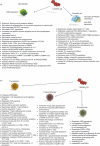Vitamin D3: a helpful immuno-modulator
- PMID: 21896008
- PMCID: PMC3194221
- DOI: 10.1111/j.1365-2567.2011.03482.x
Vitamin D3: a helpful immuno-modulator
Abstract
The active metabolite of vitamin D, 1α, 25-dihydroxyvitamin D3 [1,25(OH)(2) D3], is involved in calcium and phosphate metabolism and exerts a large number of biological effects. Vitamin D3 inhibits parathyroid hormone secretion, adaptive immunity and cell proliferation, and at the same time promotes insulin secretion, innate immunity and stimulates cellular differentiation. The role of vitamin D3 in immunoregulation has led to the concept of a dual function as both as an important secosteroid hormone for the regulation of body calcium homeostasis and as an essential organic compound that has been shown to have a crucial effect on the immune responses. Altered levels of vitamin D3 have been associated, by recent observational studies, with a higher susceptibility of immune-mediated disorders and inflammatory diseases. This review reports the new developments with specific reference to the metabolic and signalling mechanisms associated with the complex immune-regulatory effects of vitamin D3 on immune cells.
© 2011 The Authors. Immunology © 2011 Blackwell Publishing Ltd.
Figures




References
-
- Holick MF. Vitamin D: a millenium perspective. J Cell Biochem. 2003;88:296–307. - PubMed
-
- Van Etten E, Mathieu C. Immunoregulation by 1,25-dihydroxy1,25(OH)2D3: basic concepts. J Steroid Biochem Mol Biol. 2005;97:93–101. - PubMed
-
- Sigmundsdottir H, Pan J, Debes GF, Alt C, Habtezion A, Soler D, Butcher EC. DCs metabolize sunlight-induced 1,25(OH)2D3 to ‘program’ T cell attraction to the epidermal chemokine CCL27. Nat Immunol. 2007;8:285–93. - PubMed
-
- Loser K, Beissert S. Regulation of cutaneous immunity by the environment: an important role for UV irradiation and vitamin D. Int Immunopharmacol. 2009;9:587–9. - PubMed
Publication types
MeSH terms
Substances
LinkOut - more resources
Full Text Sources
Other Literature Sources

